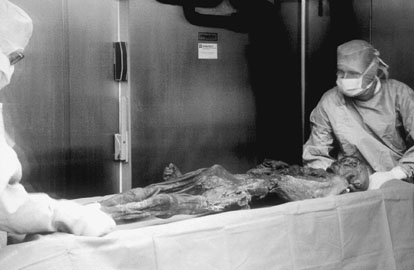

 | Page 104 |  |
that have been exposed to heat, OD measures exposure to light, that is, the stored energy released by an exposure to a beam of light, for instance, blue/green light or infrared radiation (see Aitken 1997, 183). Optically stimulated luminescence (OSL) is defined by Aitken as “commonly used as an umbrella term that includes both types of stimulation as well as use of other wavelengths” (Aitken 1997, 183).

The discovery of the 5,000-year-old frozen “ice man” in 1991 afforded a unique opportunity for the application of biological techniques to an archaeological find.
(Gamma)
Optical dating, like thermoluminescence, allows the dating of sediments. The dating of sediment became possible in the 1980s, with the dating of unburned sediment extending the chronology of Australia (Roberts, Jones, and Smith 1990).
Advances in science have given archaeologists unique insights into the social and economic development of societies through identifying trade and exchange, and they have given chronological depth to the discipline. These advances have been supported by the development of institutional laboratories. The collaboration between archaeology and physics was to bear fruit in the 1950s with the establishment of the Oxford Research Laboratory for Archaeology and Art, which arose out of the collaboration between an archaeologist (Christopher Hawkes, professor of European archaeology) and a physicist (Lord Charwell, professor of physics). Other early laboratories include the Applied Science Center for Archaeology at the university of pennsylvania museum of archaeology and the british museum. These laboratories set the standards for interlaboratory comparisons, and meeting places were arranged to ensure open dialogue among the practitioners. Subsequently, a series of conferences arose, including the International Symposium on Archaeometry, which is held every two years (the thirty-second symposium was held in 2000).
Since 1980, there has been a proliferation of journals, societies, and news groups covering the many different types of applications of science to archaeology. Since the success of the journal Archaeometry, other journals have been started, including Journal of Archaeological Sciences,
 |  |